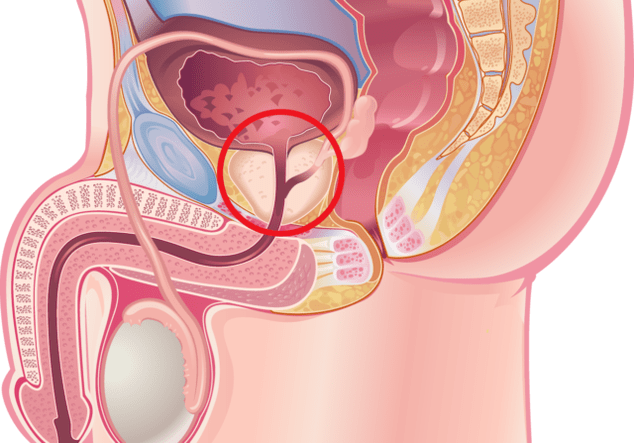Prostatitis or prostatitis ICD stands out on its list under several numbers. It all depends on the form of the pathology and the nature of its origin.
What is ICD?
There is a regulatory document used in the medical community that is periodically reviewed by the World Health Organization. It includes a list of all diseases and pathologies that occur in humans. It is called the International Classification of Diseases (ICD). Its main objective is to provide assistance in the study of the patient's condition and to create optimal conditions for this by systematically registering the available data. Information is collected from around the world and encrypted according to certain designations. At any time, it can be added and retrieved for further study.
Important! The ICD table contains classes and groups marked with codes. A heading may contain several forms and manifestations of the same disease. Entries are arranged in alphabetical order for easy tracking.

Prostate diseases according to ICD-10
The list of diseases includes:
- acute prostatitis ICD 10 41. 0;
- chronic prostatitis ICD 10 41. 1;
- prostate abscess - 41. 2;
- prostatitis - 41. 3;
- other inflammatory conditions of the prostate - 41. 8;
- unspecified inflammatory diseases of the gland - 41. 9.
The average person does not need to know ICD encoding. Only a doctor can decode and encode the diagnosis.
Prostatitis according to ICD-10
Prostatitis codes according to ICD 10 - 41. If benign hyperplasia develops in the organ, the disease is assigned under a different number. Prostate adenoma codes for ICD 10 in adults are registered with numbers 40 to 51. These titles include many different types of fibroids and fibroids.
It belongs to the most common urological diseases affecting men of all ages. In general, the inflammatory process in the glandular tissues is often observed in a chronic form without obvious acute signs in the first place.
Experts classify diseases by the nature of the course:
- acute, occurring in 50% of patients no older than 30-35 years. Mainly associated with bacterial infections;
- chronic. It does not manifest itself for a long time and can develop against the background of an infectious process.
Due to the occurrence, it happens:
- bacteria occurring in the organ;
- non-bacterial, in which pathological changes take place in a predominantly chronic form;
- virus, in which the entire genital area is affected.
By the nature of structural changes, they are distinguished:
- fiber form. The growth of glandular tissue is quite rapid and requires thorough treatment. Clinically similar to ICD prostate tumor in that 40. 0;
- calculate. It occurs when deposits are formed in the tissues of glandular organs. It is considered a harbinger of cancer;
- stagnant form. Occurs when inactivity, prolonged sexual abstinence.
Causes and symptoms
Pathologies of the gland, both chronic and acute, are directly related to the conduct of an improper lifestyle, addiction to tobacco and alcohol, and poor physical activity.
The main reasons why the disease develops even in young men are:
- sexually transmitted infections: gonococci, Escherichia coli, chlamydia, etc. Frequent change of sexual partners increases the risk of infection;
- obstruction in the pelvic organs associated with impaired blood circulation;
- sedentary lifestyle, sedentary, inactive;
- abstaining from prolonged sex, abusing drugs to prolong sex, deliberately delaying ejaculation during intimacy to prolong the duration of sex;
- reduced immunity;
- psychological - emotional stress, severe stress;
- overwork;
- Hypothermia;
- failure in the endocrine system;
- unbalanced diet;
- addicted.
The signs of the development of acute and chronic inflammation in the prostate gland are similar. The doctor will help identify the form of the disease after examination and diagnosis.
Specifics
The acute form is accompanied by severe clinical symptoms, and all tissues of the glandular organs are involved in the pathological process. Therefore, the disease causes pain, difficulty: with an increase in body temperature, a sign of general intoxication.
Patients complain of:
- heaviness and pain in the groin, pelvis, lower back;
- sensation of squeezing the rectum;
- increased need to urinate, including at night;
- urethral pain after ejaculation and bladder emptying.
In the chronic form of the disease in the lower abdomen, some men experience pain of varying intensity, problems with erection and ability to function. In 95% of cases, the disease is practically asymptomatic.

ICD codes for acute and chronic prostatitis
Chronic prostatitis ICD code 41. 1 with any adverse factor may be aggravated. Acute ICD 41. 0 inflammation leads to edema of the glandular tissues, causing acute urinary retention.
Such diseases, if not treated appropriately, lead to serious complications:
- bladder obstruction;
- the development of male infertility;
- narrowing and scarring of the urethral canal;
- recurrent cystitis;
- pyelonephritis and other diseases affecting the kidneys;
- weakening of the tissues of the gland, requiring immediate medical intervention;
- sepsis, which often develops in people with weakened immunity.
Diagnosis of disease
In some cases, a rectal examination and familiarity with the patient's complaints alone are sufficient to make a diagnosis. However, inflammation is mainly diagnosed by laboratory and instrumental testing methods.
Patients are referred to:
- blood and urine tests to identify infection and inflammation;
- analysis of secretions of the prostate gland;
- ultrasound examination of the prostate, kidneys, bladder;
- urethroscopy;
- MRI of the pelvic organs;
- PSA blood test;
- biopsy;
- X ray.
One of the most effective diagnostic methods is a digital rectal examination of the prostate gland. Although in its acute form, this organ is very sensitive, and the procedure can bring the patient severe pain.
Treatment strategies
Chronic prostatitis, ICD code listed in the international disease registry, requires complex treatment. Patients should make dietary adjustments, make lifestyle changes, give up harmful substances, and start eating right.
Also appointed:
- Medicine. It helps reduce pain, inflammation, activates regeneration of damaged cells of glandular organization. Suppositories are used mainly, as well as antibiotics.
- Prostate massage. It is considered the most effective method for eliminating stagnant processes in the gland. It is done independently or with the help of a specialist. The procedure is considered unpleasant, but it must be carried out without fail.
- Balance therapy. With the help of mineral water in sanatoriums, men can cope with the chronic form. It is very useful to drink healing water while bathing in it.
- Physical therapy. Thermal physiotherapy gives excellent results. It helps to quickly assimilate the drug, relieve general symptoms and increase blood circulation in the problem organ.
- Diet is an important step in therapy. The nursing diet must contain vitamins, fiber, amino acids and mineral compounds. You will have to limit junk food (pickles, sauces, smoked meats, fried foods, fatty foods). The wish list includes yogurt drinks, lean meat and fish, nuts, dried fruit, pumpkin seeds.
Surgery is rarely used for chronic inflammation, when other treatments have failed to give a positive effect or pyogenic processes have begun.
Acute requires the use of drugs, the use of microclysters, rectal suppositories, analgesics, analgesics. The patient was placed in bed and refused intimacy. Immediately after the acute phase has passed, prostate massage and physiotherapy are prescribed. It is very important for this type of disease to choose the necessary drugs. This can only be done after an accurate diagnosis. Experts tell what type of fund will be prescribed, and in what dosage.
Preventive
In order not to develop and aggravate prostatitis, ICD 10 code for adults listed at number 41, you should adhere to the following rules:
- lead an active and healthy lifestyle. If you can't go to the gym, you need to exercise in the morning, warm up during the work day, and walk more. A kind of gymnasium will serve as a staircase, along which a person climbs every day to get to his apartment;
- Avoid hypothermia: do not sit on cold surfaces, wear weatherproof clothing, etc. v . . . ;
- suffer from constipation, include laxative foods in the diet, take a mild laxative. If the disorder persists, see a specialist;
- regulate sex life. Prolonged abstinence from sex is the first step leading to the development of glandular diseases. If you don't have a long-term partner, you can temporarily masturbate on his behalf, but you should not engage in this activity;
- Avoid promiscuous sex without contraception. Sexually transmitted diseases may at first go unnoticed, but they seriously damage the tissues of the gland, causing an infectious form of prostatitis;
- When in the slightest doubt about a sexually transmitted infection, you should consult an obstetrician or urologist. It is enough to undergo an examination to find out what is the reason for the appearance of unpleasant symptoms;
- It is necessary to visit a urologist at least once a year to rule out the possibility of the onset of the disease.
Comment
- "The international classification is of no small importance in the treatment of prostatitis of any etiology, as the ICD-10 code allows you to accurately determine the type of disease, make a diagnosis and take measures. effective treatment. "
- "My father had a prostate tumor. The ICD code was decoded by the doctor when he was determined with the diagnosis. The period was rather neglected, the gland almost tripled. An operation was scheduled andit was successful. The recovery process was delayed, due to age (over 60 years old) and other chronic diseases made himself feel. Now he has no complaints about the genitourinary system. "
- "Chr. ICD 41. 1 prostatitis is on my card. I have had it for a long time, but it very rarely gets worse, as I do everything I can to avoid the onset of acute symptoms. The doctor said that a chronic disease that does not go away, may not appear for a very long time, if you monitor your health properly So I participate in sports - I run in the morning every day. , exercise, don't drink, don't smoke. "
























